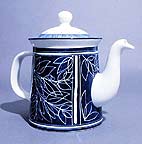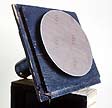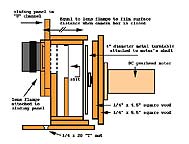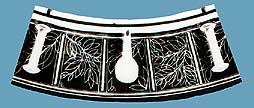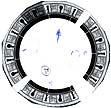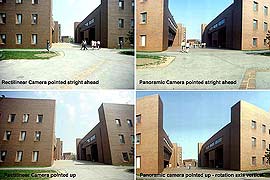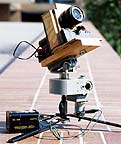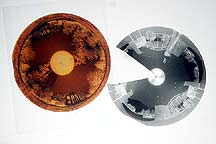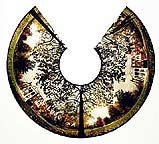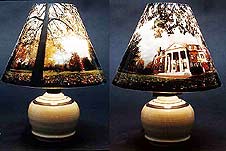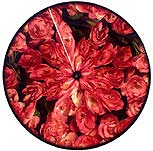|
Camera for Panoramic Photographic Lampshades and MORE Andrew Davidhazy Many years ago I was introduced to the potential for strip cameras to produce startling interpretations of ordinary subjects. This was mostly as a result of George Silk's work. He was a prominent Life photographer who used one of these cameras to photograph the 1960 Tokyo Olympics. After seeing his photographs, I became intrigued with the process and have built and experimented with these cameras ever since. There is an intriguing aspect to this type of photography. It is the fact that while there actually are many specialties within photography that depend on strip recording principles, usually few of the "specialists" are aware of how this unusual method for making images applies outside of their own area of interest. Strip cameras come in all kinds of designs and are used for a variety of applications. For example, there are racetrack photo finish cameras, peripheral and "roll-out" cameras, aerial strip cameras, synchroballistic cameras used in missile photography, document recording "flow" cameras, and finally also, panoramic cameras. Since all of these are considered special and sophisticated cameras, their price tag is usually quite high. On an "educational" budget I could not afford them so I constructed improvised versions of all of these types. I have been using them for personal research and teaching purposes in classes at the Rochester Institute of Technology under the general topic of photoinstrumentation. Having to work with "homemade" equipment is actually not as limiting as it might sound and a number of benefits have accrued to me and my students as a result of using these experimental cameras. For one, I have become quite intimately acquainted with the general operating principle of the various systems. For another, I have stumbled on many interesting applications for these cameras that would probably not have happened if I had been able to afford expensive "black-boxes" suited for single applications. Generically, what makes strip cameras different from other cameras is the fact that they are not equipped with a standard shutter that opens at the beginning of an exposure and closes at a later time, determined by the exposure time. They are equipped instead with a narrow slot in front of the film plane. The cameras also have the capability of moving the film continuously past this slot. If one allows a subject to move across the field of view of the camera and matches the speed at which the image of the subject moves with the speed at which one moves the film, a remarkably normal reproduction of the subject is captured on the film. The camera, therefore, is somewhat of a cross between o motion picture camera and a still camera. A still camera captures essentially a single instant in time, a motion picture camera records many instants over a period of time while the strip camera records a single dimension of the scene it is aimed at but displays this one dimension over time. Truly, these are time machines and they are most often used to determine the winner at races since only one picture must be made and the order of finish is definitively displayed as one of the film dimensions. I have published articles about my experiments with improvised strip cameras since the first time that Popular Photography became aware of my work and while still a student. The first article was in the September issue of 1968. Later I published a summary of various techniques in an article that was published in Modern Photography in the August issue of 1976. In addition, magazines such as Industrial Photography, Ceramics Monthly and proceedings of professional meetings of the SPSE and the SPIE have also included periodic updates.
This results in the top of the teapot moving slower than the bottom. This means the image of the teapot also moves at a different speed depending on the difference in diameter between the top and bottom of the real teapot. To solve this problem I designed a strip camera that moved the film faster at one side of its recording slot than at the other.
The lens is attached to the front end of the box by way of a camera lens flange mounted on a board that itself is able to be shifted in position so the lens axis is close or far away from the center of rotation of the disk. This is a necessary feature to produce as distortion free a record of the subject as possible. The lens carrying board is held tightly in contact with the front of the box by a "U" channel or angled lips extending over the board from each side of the panel. However, a second fortuitous accident came about later, at a meeting of the International Panoramic Photographers Association. There I became aware of problems that panoramic photographers were having when using the Goldbeck "wedge". This device supposedly allows the tilting of vintage Kodak Cirkut panoramic cameras to include lower areas of a scene than would normally be covered by simply using the lens board dropped down to its lowest position.
It occurred to me that much like the situation with the teapot this probllem was caused by differential image velocity along the exposing slit of the camera induced by the tilt angle. I also made a connection with the camera I built for the tapered teapot. Shortly thereafter I rigged up my camera to make panoramic pictures and I deliberately introduced a significant amount of vertical tilt into the picture as shown in the picture at left. I simply placed my rotating film strip camera onto a motorized head with tilt capability attached to a tripod. In this case it is not the subject that turns, as in peripheral photography such as of the teapot, but rather the camera, placed on the tilted rotating platform, that is made to rotate. As the camera rotates the film within it also rotates. Since the film is in circular motion and thus the film moves faster at the edges of the circle than close to the center, the camera is tilted upwards an appropriate amount. This degree of tilt can be determined from the amount of the circle one wishes to expose per 360 degree rotation of the camera. Detailed instructions of how to use the camera are probably beyond the scope of this article. Briefly, however, it is apparent that if one allows the camera to make a 360 degree turn and in the same time the film only makes a 180 degree turn, then the scene will be reproduced within a 180 degree "wedge" of a full circle. If one joins the two ends together one will have a cone whose side will have an angle of 60 degrees. This, then is also the degree of "elevation" that the camera must be aimed at in order for the image to be properly reproduced. In terms of reproduction, one can think of this camera as
making a conical
projection "map" of the scene in front of it. But this is probably
getting
too esoteric for the purposes of this article and the reader is
directed
to the articles listed below, especially the one published in the SPIE
proceedings for detailed mathematical treatment of the principles
of reproduction of strip cameras.
Finally, another somewhat unpredicted outcome was that although I already knew that the negatives this camera produced were circular and that a given panorama would be recorded as a section of a circle, it did not occur to me until later that the images created with this improvised camera would also provide me with a new way of seeing and interpreting the world as few others had done before.
Strip cameras in general have been a great source of inspiration and satisfaction over the years. I have made numerous conventional and circular panoramic and peripheral photographs. I have also made the acquaintances of and developed friendships with people around the world from meetings brought about while my panoramic camera was scanning a scene or while it was presented as part of a lecture on the principles of streak, strip and scanning photography. Heare are links to other related articles:Camera for Conical Peripheral and Panoramic Photography (SPIE article) http://www.davidhazy.org/andpph/text-conical-strip.html Development of a Novel Camera for Conical Panoramic Photography http://www.davidhazy.org/andpph/text-strip-iapp.html
If you would like to discuss this project with me I would be happy to provide whatever assistance is needed. Contact me by e-mail at andpph@rit.edu |
